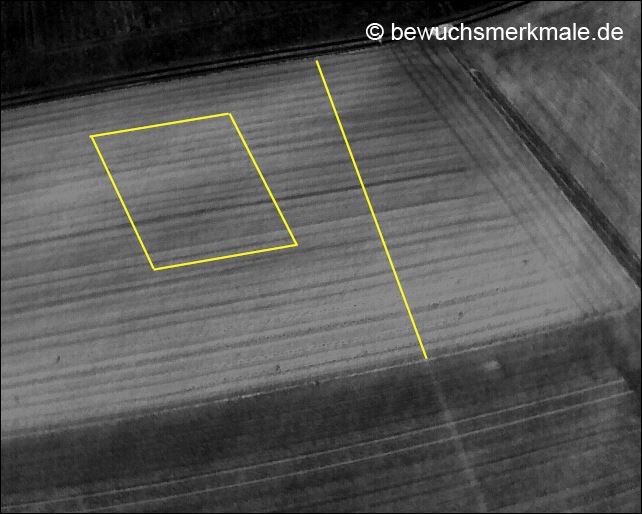Thermal characteristics of winter cereals and tilled arable land
The dry autumn/winter of 2022/2023 ensured that crop marks in the winter cereals were already forming by the end of February. On 23.02.2023, the area of a known villa rustica was surveyed. At the time of the survey, one half of the field was cultivated with winter cereals, the other half was already cultivated but not yet overgrown. In the normal image, the ground plan of the main building and part of the farm wall are visible due to negative crop marks (Fig. 1, at the bottom). The directly adjacent area, not yet overgrown, shows only some concentrations of light-coloured stones.

The thermal image taken at the same time (Fig. 2) also indicates the wall remnants visible through the negative crop marks as thermal features within the planted area, but structures in the plant-free area also become visible. Thus the line of the courtyard wall clearly continues as a warmer feature to the edge of the field. A large outbuilding, known for its massive foundation walls, can also be made out.


The photos were taken at a time when the maximum daytime temperatures had already been around 10°C for several days, there were often longer periods of sunshine and temperatures rarely fell below 0°C at night. In the previous weeks, the night temperatures were just below freezing, while the daytime temperatures were always in the positive range. It is now interesting to note that the ground above the remains of the wall has a heat difference of approx. 0.1 - 0.3°C to the neighbouring ground surfaces. A measurement of the soil temperatures in the area of the courtyard wall at the transition from the overgrown to the uncovered part of the area showed a soil temperature of 7.5 - 8.5°C (measuring depth approx. 10 cm). The temperature difference visible in the thermal image was not clearly detectable in the soil measurements.
I think it is unlikely that the remains of the wall have stored a certain amount of residual heat over the winter, which is transferred to the soil above. The cause is more likely to be a combination of the first longer periods of sunshine and the water content in the soil: During the night, the soil moisture has spread evenly over the surface of the field. The water evaporates from the upper soil layers with the sunlight. While cooling water is drawn from the deeper subsoil in the soil next to the wall remains due to capillary action, this effect is much less pronounced above the impermeable wall remains. As a result, the soil above the wall remains heats up slightly more due to solar radiation.

